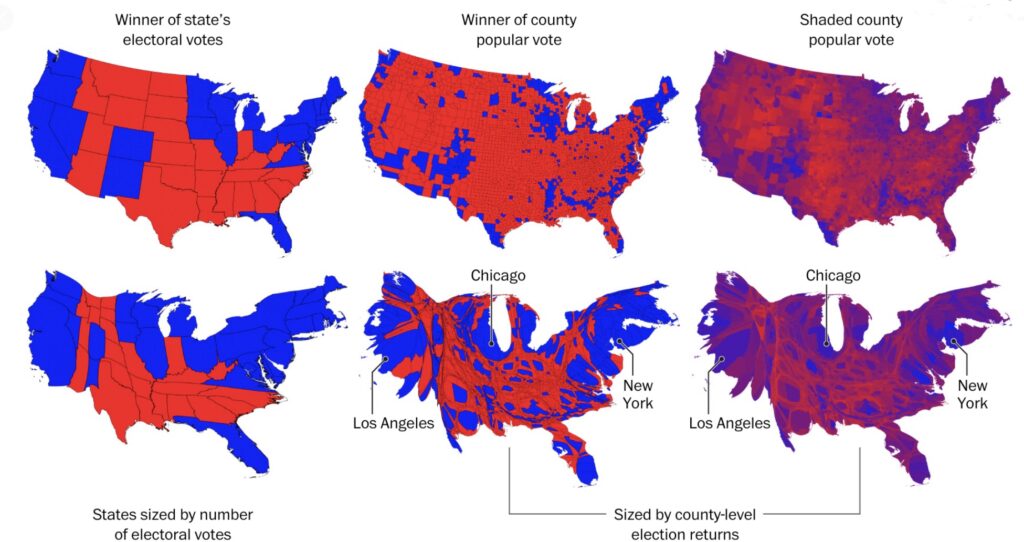
Patience, please…Democracy is at work.
Read the LWVGR article in the Rockford Register Star Newspaper, published Saturday, October 31, 2020.
Listen to the LWVGR Perspectives edition, “Strengthening Our Democracy,” on WNIJ, Northern Public Radio Wed., Nov. 4, 2020.
The LWVGR has compiled this information using several non-partisan sources. There is a full bibliography at the end of the page.
The Electoral College: It’s a Process, not a Place
The Electoral College is how we refer to the process by which the United States elects the President, even though that term does not appear in the U.S. Constitution. In this process, the States (which includes the District of Columbia just for this process) elect the President and Vice President.
The Office of the Federal Register (OFR) is a part of the National Archives and Records Administration (NARA) and, on behalf of the Archivist of the United States, coordinates certain functions of the Electoral College between the States and Congress. Acting as an intermediary, it reviews the Certificates of Ascertainment and Vote before Congress accepts them as evidence of official State action in preparation for the counting of electoral votes in Congress. In addition to posting them on their website, OFR makes the physical Certificates available for public inspection for one year following the election. After that year, the Certificates become part of the National Archives collection.
OFR has no role in appointing electors and has no contact with them.
Electoral College Timeline of Events
November 3, 2020—Election Day
(first Tuesday after the first Monday in November)
During the general election your vote helps determine your State’s electors. When you vote for a Presidential candidate, you aren’t actually voting for President. You are telling your State which candidate you want your State to vote for at the meeting of the electors. The States use these general election results (also known as the popular vote) to appoint their electors. The winning candidate’s State political party selects the individuals who will be the electors.
Mid-November Through December 14, 2020
After the presidential election, the Governor of your State prepares seven Certificates of Ascertainment. “As soon as practicable,” after the election results in your State are certified, the Governor sends one of those original Certificates of Ascertainment to the Archivist.
By December 8, 2020—States Resolve Controversies
(at least six days before the meeting of the electors)
States must make final decisions in any controversies over the appointment of their electors at least six days before the meeting of the electors. This is so their electoral votes will be presumed valid when presented to Congress. Decisions by States’ courts are conclusive, if decided under laws enacted before Election Day.
December 14, 2020—Electors Vote in Their States
The electors meet in their respective States and vote for President and Vice President on separate ballots. The electors record their votes on six Certificates of Vote, which are paired with the six remaining Certificates of Ascertainment. The electors sign, seal, and certify six sets of electoral votes. A set of electoral votes consists of one Certificate of Ascertainment and one Certificate of Vote.
December 23, 2020—Electoral Votes Arrive
Electoral votes (the Certificates of Vote) must be received by the President of the Senate and the Archivist no later than nine days after the meeting of the electors. If votes are lost or delayed, the Archivist may take extraordinary measures to retrieve duplicate originals.
On or before January 3, 2021—Archivist Transfers Certificates to Congress
As the new Congress assembles, the Archivist transmits sets of Certificates to Congress, as requested. This generally happens when the Senate does not receive its set of Certificates on time. The transfer occurs in late December or early January when OFR’s Legal staff meets with representatives of the Secretary of the Senate and the Clerk of the House. (The 117th Congress takes its seat January 3, 2021; the new Congress will certify the election.)
January 6, 2021—Congress Counts the Electoral Votes
Congress meets in joint session to count the electoral votes. The Vice President, as President of the Senate, presides over the count and announces the results of the Electoral College vote. The President of the Senate then declares which persons, if any, have been elected President and Vice President of the United States.
If any objections to the electoral votes are made, they must be submitted in writing and be signed by at least one member of the House and one Senator. If objections are presented, the House and Senate withdraw to their respective chambers to consider the merits of the objection(s) under procedures set out in Federal law.
If no Presidential candidate wins at least 270 electoral votes (a majority of the 538 available votes), under the 12th Amendment to the Constitution the House of Representatives decides the Presidential election. If necessary, the House would elect the President by majority vote, choosing from among the three candidates who received the greatest number of electoral votes. The vote would be taken by State, with each State having one vote. (The District of Columbia does not vote because it doesn’t have voting members in the House of Representatives.)
If no Vice Presidential candidate wins at least 270 electoral votes (a majority or the 538 available votes), under the 12th Amendment the Senate elects the Vice President. If necessary, the Senate would elect the Vice President by majority vote, choosing between the two candidates who received the greatest number of electoral votes. Each Senator would have one vote.
January 20, 2021 at Noon—Inauguration Day
The President-elect and Vice President-elect take the Oath of Office and become the President of the United States and Vice President of the United States, respectively.
How would you put The Electoral College together to acquire 270 electors?
2020 Electoral College Results Tracker
Keep track of the official count.
How long will vote counting take? Depends on your state laws.


State-by-State election tabulation laws.
How Recounts Effect Electoral College Results

Read an article explaining the recount process.
To be…or not to be?

The Electoral College has become controversial. Should we continue using it? Netivist, a public engagement discussion website, presents both sides.
Quiz:
Test Your Electoral College Knowledge.
Bibliography:
The United States National Archives website is a compendium of every possible fact available about the United States electoral college. You are encouraged to go to the site and find even more detail.
https://www.archives.gov/electoral-college
Electoral College description and procedural timeline. https://www.archives.gov/electoral-college
State-by-State election tabulation laws. https://www.nytimes.com/interactive/2020/10/27/upshot/election-results-timing.html
Electoral College results tracker.
https://www.archives.gov/electoral-college/2020
Electoral College Quiz.
https://www.aarp.org/politics-society/government-elections/info-2016/the-electoral-college-quiz.html
The United States Constitution, Amendment 12.
https://constitutionus.com/#x12

